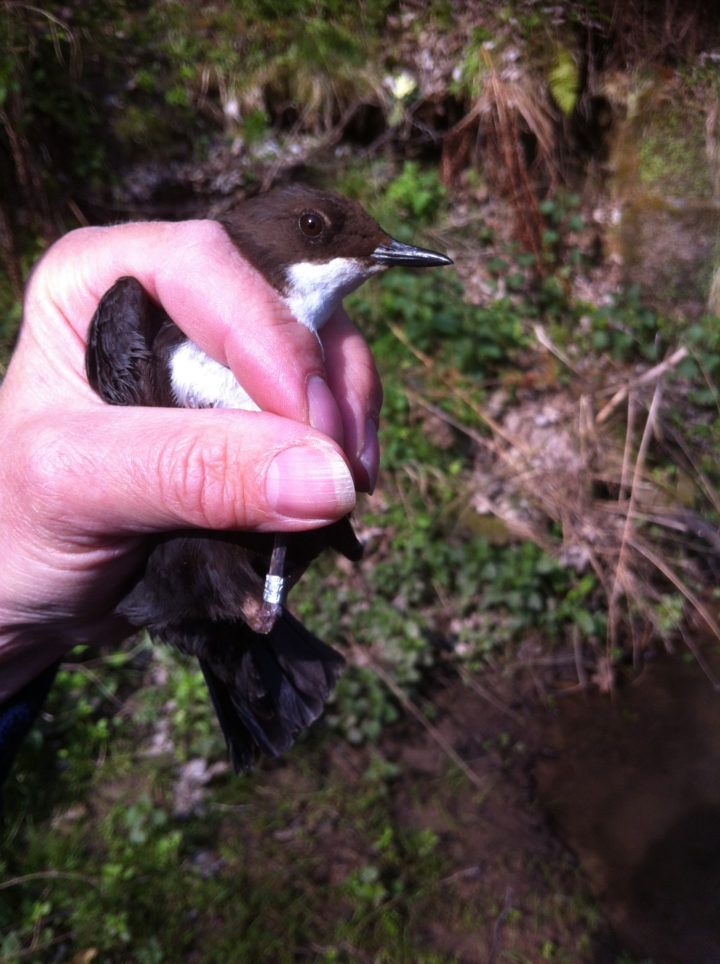April 2019: Most activity this month has been in respect of larger nesting birds but I have done some ringing near home with trainees which netted 14 Siskins (out of 20 odd birds) on the 6/4/19; two were ‘my’ older retraps from spring 2018. One was a female with a very clear Brood patch indicating that she was incubating. We also captured a brand new Chiffchaff just returned from foreign parts. On the 12th we captured another 20 odd birds including a Robin from Spring 2017; a new Blackcap; another Chiffchaff; 5 Siskin (2 with brood patches); and 7 Tree Sparrows of which two were just starting to show a brood patch (so preparing to nest). Subsequent small catches have confirmed that Siskins are now breeding seriously but Goldfinches (for example) are not doing so yet.
Last month I reported on a dead Swan so it’s nice to report that Mute Swan (ZJU) which was ringed as a cygnet at Howick in September 2017 appears to be living at the Queen Elizabeth Country Park near Woodhorn, Ashington. Remember it’s perfectly OK to feed ADULT swans bread (indeed in the winter they often need it) but you should not feed bread to Cygnets (look for them at the end of May or June) because it swells up in their little stomachs – and they think they have a meal but in fact may be slowly starving. An unfortunate bird that was found near Howick; dead this month was a Barn Owl. However, it was actually ringed in its nest (along with two siblings) in July 2014 in a small Hemmel just north of Alnwick; so at 5 years old it lived a reasonable time. Another found dead at the Breamish Caravan Site had only travelled a short distance but was ringed as an ‘adult’ from 2016; so was at least 4 years old but quite possibly older. Another was found dead after having been hit by a vehicle on the A1 near Warenford; this was barely a year old having been ringed near Low Newton in 2018.

Better news was the finding of a nesting Dipper (see picture) in Hulne Park with 5 warm eggs; although at least two other traditional sites seemed to be deserted when I did my annual survey. These birds nest quite early although can have more than one brood; especially if the first fails. Tawny Owls on the other hand only have one brood and I have been introducing new trainees to these potentially dangerous birds that need careful handling. The danger comes from their general lack of fear of man and their very sharp and powerful talons (see picture). On approaching a box the owls do one of two things: either purposefully ignores the inquisitive ringer OR they come barrelling out looking for a fight – and we catch them in a net. I am pleased to say that we have so far found two new breeding females and several ‘old friends’. One of the old friends did come out from a nest near Powburn and on checking her ring we could confirm that she was first ringed in 2017; she is at least four years old and has 3 eggs (a normal sort of number in Northumberland); see photo. One of the new birds is in a box near my home – that was last occupied in 2017 when a 13-year-old bird (originally ringed by my son) was seen for the last time. We presume she has since died and this new bird has taken over the box.
Finally, this is the time of year I census Northumberland’s very rare breeding ducks; the Goldeneye. These ‘should’ migrate further north to nest but at what still appears to be their only breeding ‘colony’ in England we have around about 10 breeding females. As part of research to try and determine where ‘our’ Goldeneye go to when not actually nesting I am trying to retrieve ‘Geo-loggers’ from at least four birds that had them fitted last year. So far we have recaptured two ducks and retrieved two loggers. These particular females hatched duckling broods of 4 and 14 (!) respectively last May. It looks like we may have at least two entirely new nesting females this year but this is yet to be confirmed when we catch up with them (see picture).
Anyone interesting in ringing is invited to get in touch. Phil Hanmer ‘A’ Ringer/Trainer; Natural History Society of Northumbria Ringing Group (Hancock Museum). E-mail: tytoalbas@btinternet.com
Phil Hanmer, Ornithologist